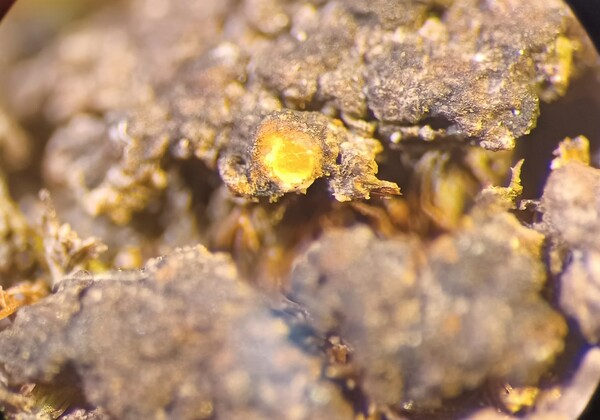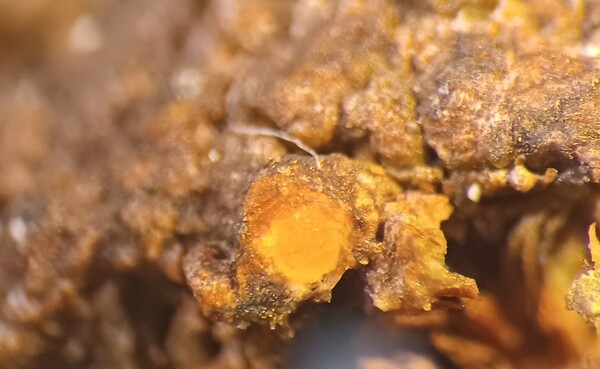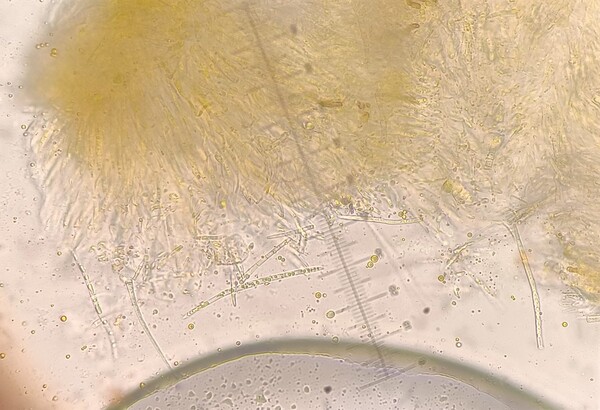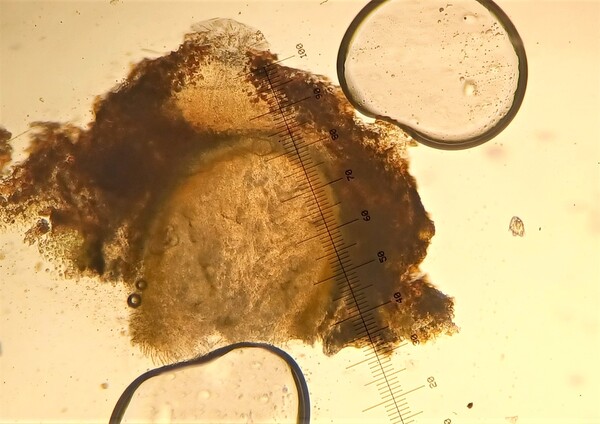Gyalecta russula (Nyl.) Baloch, Lumbsch & Wedin
in Baloch & al., Lichenologist, 45: 725, 2013. Basionym: Belonia russula Körb. ex Nyl. - Act. Soc. Linn. Bordeaux, 21: 346, 1856.
Synonyms: Belonia fennica Vain.; Beloniella cinerea Norman; Gyalecta bacidiospora (Eitner) Zahlbr.; Secoliga bacidiospora Eitner
Distribution: N - Frl, TAA (Arnold, Lich. Exs. 1066: UPS-L-169726, Nascimbene & al. 2022), Emil (Benesperi & al. 2007, Tretiach & al. 2008, Fariselli & al. 2020). C - Tosc (TSB 36800).
Description: Thallus crustose, thinly episubstratic, inconspicuous to granular-warted, the warts 0.4-0.7 mm wide, grouped or dispersed, pale yellowish brown to dark reddish grey or dark reddish brown. Ascomata perithecioid, (0.2-)0.4-0.6 mm across, immersed in the thalline warts, dull reddish brown, translucent when wet, the area around the apical pore pale grey. Proper exciple more or less covered by a thalline layer, yellowish to pale reddish brown, darker around the ostiole; hymenium colourless, the hymenial gel hemiamyloid; paraphyses slender, loose, septate, mostly simple, arising from the base of the ascocarp. Asci 8-spored, narrowly cylindrical, thin-walled, without apical thickenings, the wall K/I+ blue. Ascospores (4-)10-20-septate, hyaline, needle-like, (50-)75-100(-125) x 3-4(-6) μm, with cylindrical cells. Photobiont trentepohlioid. Spot tests: thallus K- or K+ weakly yellow, C-, KC-, P-, UV-. Chemistry: without lichen substances.Note: a mainly arctic-alpine, probably circumpolar species found on base-rich soil, often on bryophytes, and on steeply inclined or rain-sheltered surfaces of basic siliceous rocks, with optimum above treeline; perhaps more widespread in the Alps, but generally not common.
Growth form: Crustose
Substrata: rocks, soil, terricolous mosses, and plant debris
Photobiont: Trentepohlia
Reproductive strategy: mainly sexual
Commonnes-rarity: (info)
Alpine belt: very rare
Subalpine belt: extremely rare
Oromediterranean belt: absent
Montane belt: absent
Submediterranean belt: absent
Padanian area: absent
Humid submediterranean belt: absent
Humid mediterranean belt: absent
Dry mediterranean belt: absent

Predictive model
Herbarium samples


P.L. Nimis; Owner: Department of Life Sciences, University of Trieste
Herbarium: TSB (35004)
2002/05/15
Growth form: Crustose
Substrata: rocks, soil, terricolous mosses, and plant debris
Photobiont: Trentepohlia
Reproductive strategy: mainly sexual
Commonnes-rarity: (info)
Alpine belt: very rare
Subalpine belt: extremely rare
Oromediterranean belt: absent
Montane belt: absent
Submediterranean belt: absent
Padanian area: absent
Humid submediterranean belt: absent
Humid mediterranean belt: absent
Dry mediterranean belt: absent

Predictive model
| Herbarium samples |


 Index Fungorum
Index Fungorum
 GBIF
GBIF










